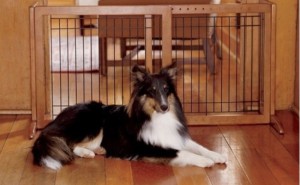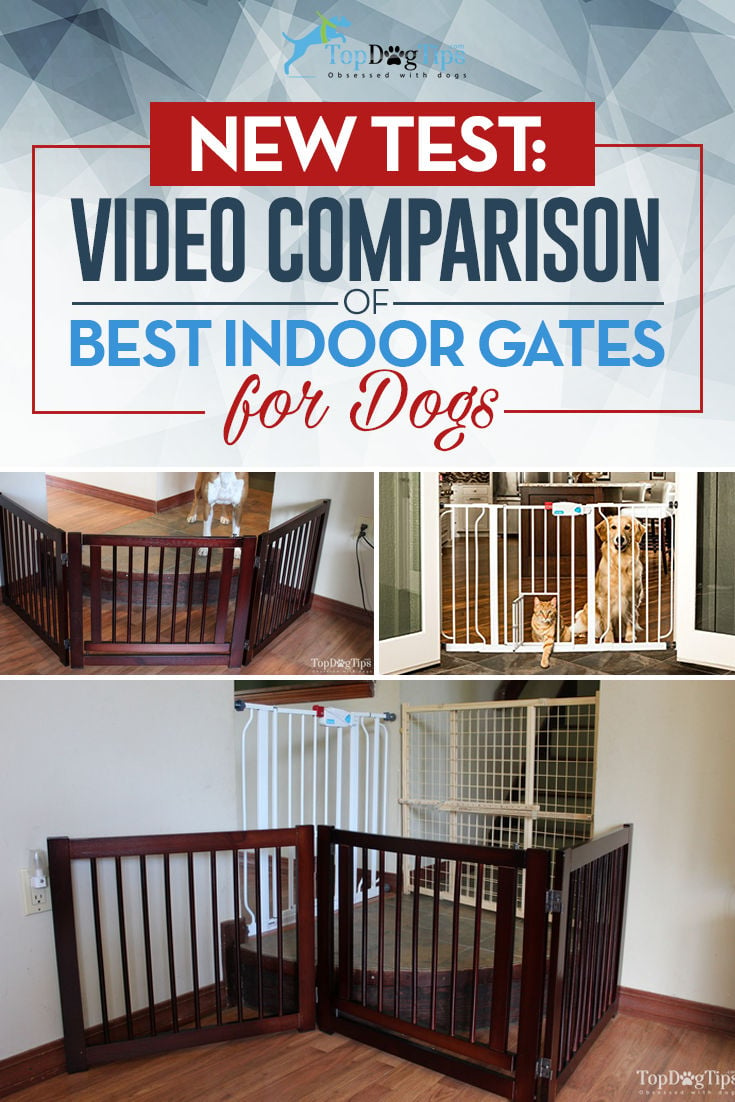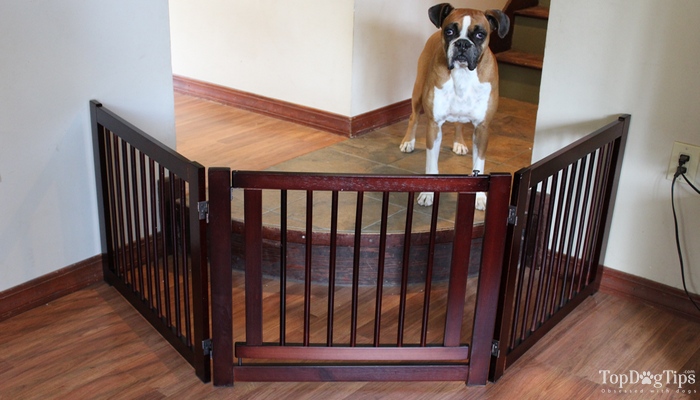Table of Contents
You're in the market for pet gates. Most pet owners think choosing indoor dog gates sounds simple.
Measure the space and buy one that fits, right? But if that's all you consider, then you run the risk of buying a dog gate that will be completely useless.
 We've tested and reviewed many different dog gates for the house and have some important tips to share before you buy your first gate.
We've tested and reviewed many different dog gates for the house and have some important tips to share before you buy your first gate.
There are close to a hundred different pet gates for dogs and cats available on Amazon and other online retailers.
Finding the one that will work best for your dog and your home will require a bit more research.
Here are some of the things you need to consider because it will determine which pet gates you will need to consider:
- Do you have a large, medium, or small dog(s)?
- Do you have cats as well?
- What if you have both large and small dogs, as well as a cat at home?
- How active is your dog?
- Do you live in an apartment or a house?
- Do you want the indoor dog fence to fit your home decor?
- Do you want a mobile dog gate with a door that's easy to move all the time?
Some pet gates will work great for certain dogs and situations, while others will not be as effective.
Samantha has previously done a video comparison of the three most popular dog gates and explained the pros and cons of each.
That article and video will get you started on your journey to picking the best indoor pet gate for your dog, but here are a few more things you'll be glad you knew in advance.
ALSO READ: 15 Reasons to Consider Pet Safety Gates for Your Dog
Indoor Dog Gates: A Quick Buyer’s Guide
What types of indoor pet gates exist for dogs?
The first thing you will need to do is decide what type of indoor pet gates for dogs will work best for your situation.
While there are some variations and additional features to each dog gate based on the manufacturer, the main three types are:
 Pressure-mounted dog gates – these pet gates are held in place by applying pressure against the door frame or walls. This is a very popular choice for most pet owners because they're easy to install, and they usually are the cheapest.
Pressure-mounted dog gates – these pet gates are held in place by applying pressure against the door frame or walls. This is a very popular choice for most pet owners because they're easy to install, and they usually are the cheapest.
Pressure-mounted pet gates are a good balance between security and mobility.
- Example: Regalo Easy Step Walk Thru Gate
 Hardware-mounted gates – these ones need permanent hardware to attach them to the door frame or wall studs. Because of how immobile and difficult to install these dog gates are, they are the least popular option but the most secure and sturdy.
Hardware-mounted gates – these ones need permanent hardware to attach them to the door frame or wall studs. Because of how immobile and difficult to install these dog gates are, they are the least popular option but the most secure and sturdy.
They're more expensive than pressure-mounted gates but cheaper than freestanding pet gates.
- Example: Summer Infant Multi-Use Walk-Thru Gate (dual option)
 Freestanding dog gates – another popular choice of dog gates but for different reasons. Enclosures of these indoor pet gates don’t attach to anything, which makes them very mobile and easy to install and move.
Freestanding dog gates – another popular choice of dog gates but for different reasons. Enclosures of these indoor pet gates don’t attach to anything, which makes them very mobile and easy to install and move.
They stand up on their own; however, that means they are the least secure option, especially for big or active dogs. These gates often complete home decor.
- Example: Richell Wood Freestanding Pet Gate
Which type of indoor pet gates you should choose will depend on where you're going to install them, what dog(s) and cat(s) you have, and how many of them you'll want to contain.
So, let's talk a little more about how to choose the best pet gate for your situation.
Which Dog Gates Will Work Best for Your Home and Dog?
One of the most common places pet owners put an indoor dog gate at home is at the top or bottom of stairs.
When placing a pet gate at the top of stairs, be sure to use a hardware-mounted gate so there is no chance of it falling over if your pet or a person puts pressure on it.
For the bottom of the stairs, you can use either pressure-mounted or hardware-mounted pet gates.
Hardware-mounted gates are also a great choice for any area in your home where you know it won't be moved for a long time.
The main advantage is that these pet gates will stay secure and immovable, which is a perfect choice for large dogs, hyperactive dogs, or multiple dogs.
The disadvantage is that you have to install them directly into stairs or walls, which affects your home decor and also takes time to take down.
Here's what installed hardware-mounted pet gates look like:

Pressure-mounted gates are a good alternative to hardware-mounted in several different cases: (a) if you're not sure whether you'll need to move the gates or not, (b) if you don't want to use hardware to install the gates into stair railings or walls, thereby affecting your home decor.
The disadvantage of these gates is that they aren't as secure and sturdy as hardware-mounted pet gates.
Here's what installed pressure-mounted pet gates look like:

Freestanding gates are the least sturdy and secure option out of these three.
They are best used in the middle of the room or somewhere where you are unable to use pressure-mounted gates or are unwilling to install hardware-mounted gates. They are often a good choice for smaller places, like apartments.
The advantage of freestanding pet gates is that they are easy to move, very mobile, and can be put up anywhere quickly. Most also are much better looking (made of stylish wood).
The disadvantage is that they are easier to tip over because they're not secure, and they're also the most expensive option.
Here's what freestanding pet gates look like:

Freestanding pet gates are the most versatile option because you can block off any area in your house or apartment that you don’t want your pooch (or cat or baby) to enter, and when you need the extra space, you can take the gate down and store it easily under a bed or in the closet.
Another advantage of freestanding dog gates like Richell is that if you buy a larger one with at least 6-8 panels, then you can use that as a pet playpen.
When testing and reviewing several dog playpen options, we've found that Richell's pet gates work just as well as any regular pet playpen.
Freestanding pet gates also don’t require any hardware whatsoever, so there is no damage to the walls.
The bottom line
All three types of dog gates come with their own pros and cons.
In conclusion, once you know how you're going to use the pet gate, where are you planning on placing them (and whether it's a single location or multiple locations), and who are you using it for (which dogs and how many), it will be much easier to pick the right type of dog gates.
Small Dogs (and Cats) vs Big Dogs
Finding a pet gate to contain a small breed dog is very simple.
As with pet doors, dog ramps, or dog playpens (sometimes used for babies), the majority of pet gates will work perfectly fine for small dogs since they cannot tip over even the freestanding gates.
However, finding the best dog barrier that will contain a large breed can sometimes prove to be rather difficult, especially if you're concerned with the location of the gate and aren't happy damaging your stairs or walls with hardware mounts.
But the only difficulty here is the lack of options because there are simply fewer for you to choose from.
Ultimately, if you're only concerned with the effectiveness of indoor pet gates for your large dog, then you need to pick the one with tall enough panels so that they can’t just walk or jump over it, which is also sturdy enough so that they can’t just knock it over to get around it.
Freestanding pet gates are not recommended for large breeds, as well as some cheap pressure-mounted pet gates.
Hardware-mounted dog gates are best, but some more expensive pressure-mounted pet gates will work as well.
Home with Pets of All Sizes
If you have large and small pets in the same home, it will get very frustrating if you have to constantly pick up the smaller animals and put them on the other side of the gate.
Certain pet gates that are sturdy enough for large dogs can also be ineffective for small dogs or cats because they can easily walk through the gate due to their small size.
In that case, you should pay close attention to the width of the openings of pet gate panels.
If you want to contain the large dog but let the small dogs or cats through, you can buy a dog gate with a small pass-thru door built into it.
Think of it as a pet gate with a small dog/cat door on the bottom for them to enter and leave whenever they please. This way, your smaller animals can pass through the gate without trouble, but your larger dog is still confined.
These types of pet confinement barriers are rare, but one of the most popular options is Carlson's walk-through gate with a pet door:

Indoor Dog Gates: Final Thoughts
Understanding what you want out of your indoor dog gate and which type will be most effective for your pets at home can save you money, time, and stress.
Start by measuring your dog(s) and the location of where you want to place the gate.
Then, consider how you're going to install and use the dog gates for the house. Once decided, take a look at several options, and you may find that even the cheapest indoor dog fence will work perfectly well for you.
READ NEXT: Playtime Protectors – Dog Playpens or Pet Gates?

Disclosure: We may earn affiliate commissions at no cost to you from the links on this page. This did not affect our assessment of products. Read more here and find full disclosure here.













